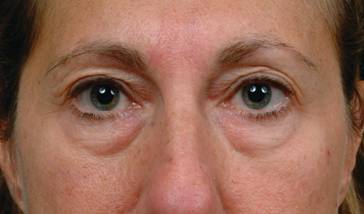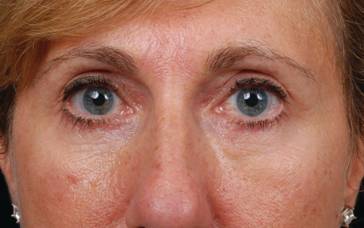Sunday, October 3, 2010 - 10:15 AM
18336
An Integrated Approach to Lower Blepharoplasty
Background: Lower blepharoplasty was most commonly performed by skin-muscle flaps in the 1970-1980s before the popularization of transconjunctival fat excision and CO2 laser resurfacing in the 1990s. Limitations of these techniques has lead to the concept of fat preservation with blending of the lid-cheek junction,1-2 more simplified skin excision, and less morbid resurfacing techniques. The concept of not violating the orbicularis muscle to preserve its innervations and reduce translamellar scarring is believed important in preventing lower eyelid malposition, as is the liberal use of lateral canthal tightening techniques.3 This study investigates the use of a combined transconjuctival approach to resect and transpose fat and an subciliary approach to resect skin and simultaneously resurface an extensively raised skin flap with a milder resurfacing agent (30% TCA). The orbicularis is not violated and either a cantholytic suspension of the lower eyelid or temporary tarsorrhaphy is used as necessary.
Methods: Lower blepharoplasties were performed in 248 patients (24 men, 224 women) between 3/3/2006 and 3/3/2010. Component procedures included fat excision, fat transposition, skin excision, 30% TCA peel, cantholytic canthopexy without canthotomy, and temporary tarsorrhaphy. Component procedures were selected based on individual anatomy.
Results: Fat excision was performed in 91%, fat transposition in 61%, skin excision in 63%, TCA peels in 62%, canthopexy in 18%, and temporary tarsorrhaphy in 31%. The average follow-up was 5.5 months. There were 9 revisions (three for eyelid malposition).
Conclusions: Lower blepharoplasty consisting of component techniques selected based on individual anatomy and that spare the orbicularis muscle is effective and associated with few complications. Fat transposition by a simplified technique achieves effective blending of the lid-cheek junction. Complete skin flap elevation, as opposed to pinch excision4, is more effective in eliminating rhytids and is safe for simultaneous resurfacing with a mild peeling agent. Selective use of lateral canthal support minimizes eyelid malposition problems.
 |  |
| Fat resection and transposition |
1. Hamra ST. Arcus marginalis release and orbital fat preservation in midface rejuvenation. Plast Reconstr Surg. 1995;96:354-3622.
2. Kawamoto HK, Bradley JP. The tear “TROUF” procedure: Transconjunctival repositioning of orbital unipedicled fat. Plast Reconstr Surg. 2003;112:1903-1907.
3. Fagien S. The lateral retinacular suspension: a simplified suture canthopexy. Plast Reconstr Surg. 1999;103:2042-2053.
4. Rosenfield L. Pinch blepharoplasty: A safe technique with superior results. Aesthetic Surg J. 2007;27:199-203.
See more of Cosmetic Paper (5 mins)
Back to 2010am Complete Scientific Program
